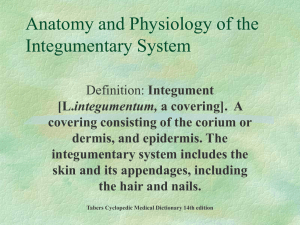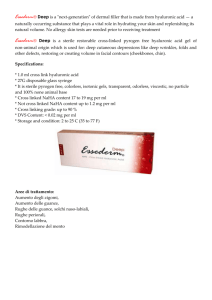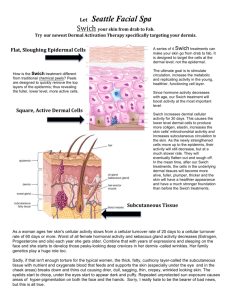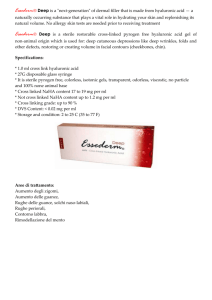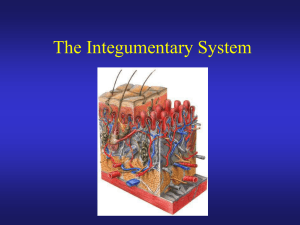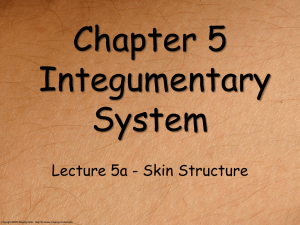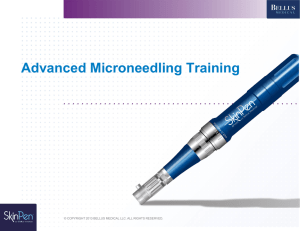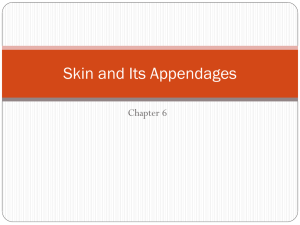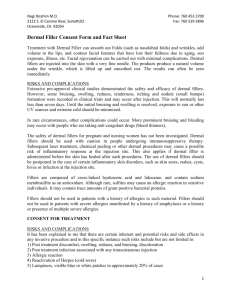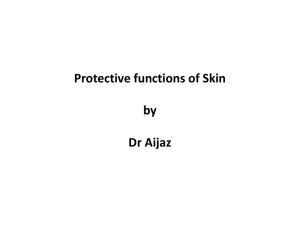Chapter 5: The Integumentary System
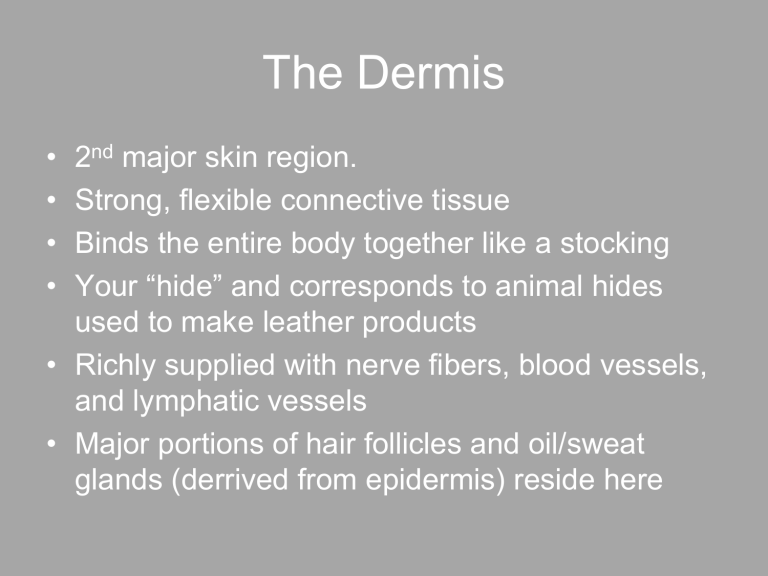
The Dermis
• 2 nd major skin region.
• Strong, flexible connective tissue
• Binds the entire body together like a stocking
• Your “hide” and corresponds to animal hides used to make leather products
• Richly supplied with nerve fibers, blood vessels, and lymphatic vessels
• Major portions of hair follicles and oil/sweat glands (derrived from epidermis) reside here
The Dermis – Papillary Layer
• Superficial layer
• Areolar C.T.
• Thin layer
• Composed of
(areolar) connective tissue
The Dermis – Papillary Layer
• Superior surface has peg-like projections called dermal papillae .
– Increase surface area where epidermal cells receive oxygen and nutrients from dermal capillaries
The Dermis – Papillary Layer
• On the palms of the hands and the soles of the feet, the dermal papillae lie on larger mounds called dermal ridges these form the epidermal ridges
(fingerprints)
The Dermis – Reticular Layer
• Deep layer
• Accounts for 80% of dermal thickness.
• Composed of dense irregular connective tissue
• Responsible for the lines on your palms, wrist, etc.
• Stretch marks extreme stretching of dermis to cause a tear
The Dermis – Reticular Layer
• Cleavage or Tension Lines
– Collagen and elastic fibers at any one location are arranged in parallel bundles
– Bundles are aligned to resist the applied forces
– Clinical significance:
• Parallel cut cut will remain closed, heal faster, and less scaring
• Perpendicular cut cut will be pulled open, heal slower, more scaring
The Dermis – Reticular Layer
• Flexure Lines
– Dermal folds that occur near joints, where the dermis is tightly secured to deeper structures
– Skin can’t slide easily to accommodate motion – so the fold occurs
– Ex. Lines in your
Palms.
Tattoos!
• Very fine needles inject inks into the dermis.
• The color is permanent because dermal cells aren’t shed.
• To remove a laser is used to shatter the ink molecules and then the immune system removes the debris.
• Before lasers tattoo was scraped, frozen, or cut away!
OUCH!!
Skin Color
• Due to:
1. Pigment composition and concentration
2. Dermal blood supply
• Skin Color:
– Skin comes in different colors!!
– Distribution of skin color is not random!
– Darker skinned people live near the equator need most protection from the sun
– Lighter skinned people live near the poles
Skin Color - Pigments
• Melanin
– Color Yellow reddish brown black
– No matter how dark or light skinned a person is, they have about the same number of melanocytes!!
Albinism
• Mutant gene that makes melanin is inherited melanocytes don’t work correctly individual has non-pigmented skin.
• Affects people of all races and many species of animals.
Skin Color - Carotene
• Orange-yellow pigment
• Located:
– S. corneum of light-skinned individuals
– Adipose tissue of hypodermis (gives fat its yellow color)
• If eat too much then skin can have an orange cast because the pigment will accumulate in adipose tissue
– Orange colored vegetables
• Can be converted to vitamin A
– Required for:
• Normal maintenance of epithelia
• Synthesis of photoreceptor for pigments in the eye
Jaundice
• Most often seen in newborns yellowish skin
• Caused by blood incompatibility or immature liver an accumulation of bilirubin in skin.
• Cured by sunlight! Enables the body to break down the bilirubin.
Skin Color – Dermal Circulation
• Blood contains pigment hemoglobin
– Binds and transports oxygen
– When oxygen is bound bright red
– When oxygen isn’t bound dark red
• Most apparent in lightly pigmented individuals
– Lots of blood flow (inflammation) bright red
– When circulation is reduced pale
– Sustained reduction in circulation very dark red (blue/purple)
– Because Caucasian skin contains only small amounts of melanin, the epidermis is nearly transparent and allows hemoglobin’s color to show through
Epidermis and Vitamin D
3
• Limited sun exposure is very beneficial!!
• Epidermal cells exposed to UV radiation
– Vitamin D
3 is converted into calcitriol which is necessary for calcium (bones) and phosphorus (muscle contraction) absorption in the small intestine.
– An inadequate supply of calcitriol leads to impaired bone maintenance and growth.

